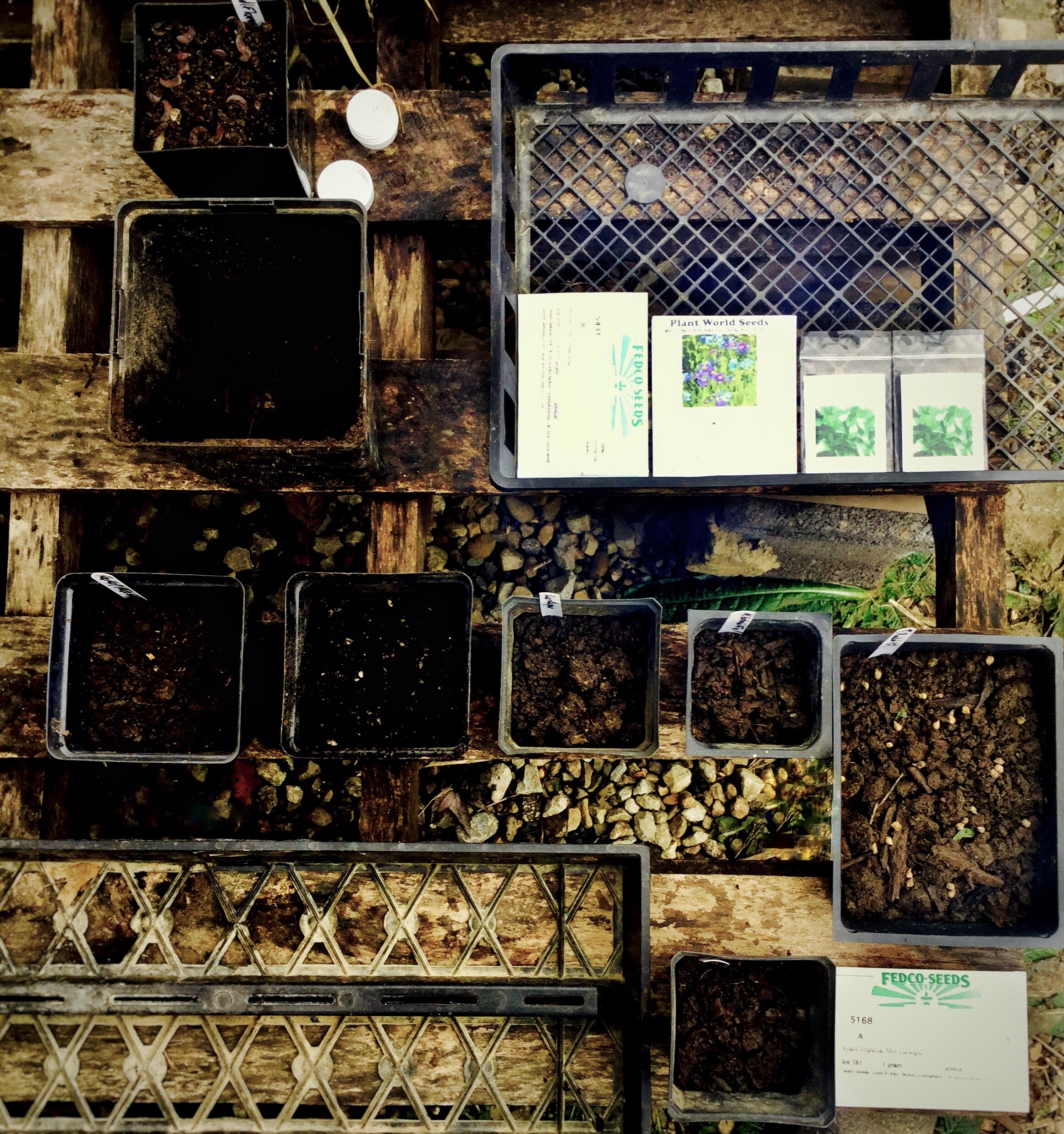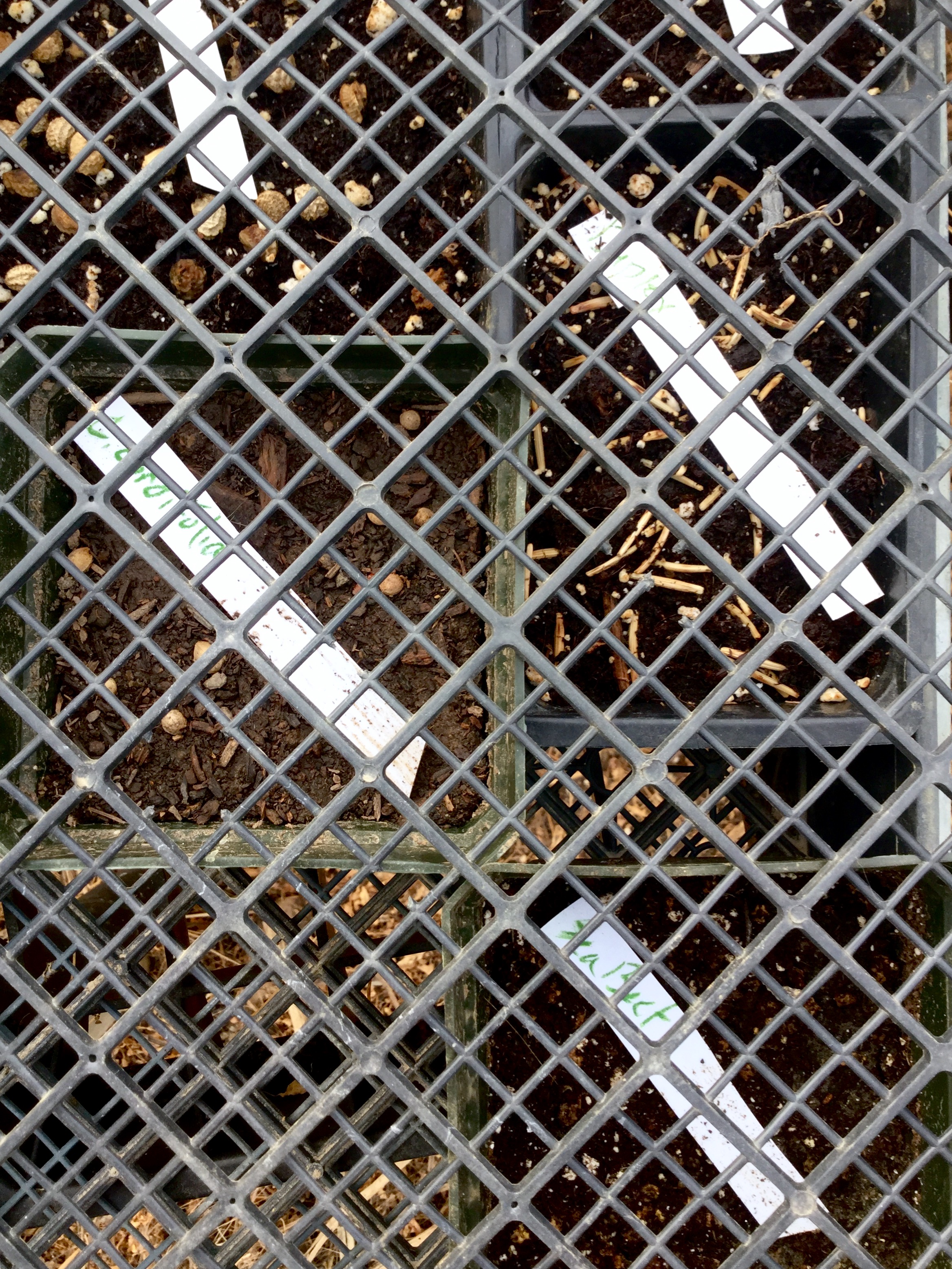I’m not quite sure what it takes to sprout Turkish rocket (Bunias orientalis). Last year I posted a fairly certain observation that a couple weeks in cold temperatures does the trick, only to find in the comments from the ever apt Wooddogs3 that she had sprouted quite a few straight out of the packet in warm weather.

Scratch that idea. I figured something else must have deterred my Turkish rocket sprouts; but then, in later conversation, she mentioned that more Turkish rocket sprouted after the pot sat out over winter. (?)
I think the fact of the matter is we are working with fairly wild, unselected seeds. With them, variance is the standard. At the same time, it offers several little known benefits.
Varying the time of germination increases the likelihood at least some of the seeds will sprout in a ‘sweet spot’ of a season, or at least avoid catastrophes, and make it to adulthood. What if an unusually late frost hits or some animal nips off the tender sprouts?
This is a very helpful character for love-in-a-puff vine (Cardiospermum halicacabum) which I’ve grown on a large scale for the last couple years. It’s a warm climate plant, and can’t take frost. I nevertheless plant it in mid April, when we still have a chance of frost. While a few will come up as early as three days after planting and get nipped, the majority of the plants take about two weeks to sprout, and will continuing sprouting up to three months after.

The mechanics that govern this variance can vary, but are usually based on the activity of certain enzymes releasing nutrients necessary to wake up and nourish the embryo that will become the new plant.
Health conscious readers may be familiar with the discussion of improved nutrition in sprouted or soaked grains because the phytates present in these seeds have been removed (see here for more info). This is because in the seed, phytates bind up nutrients -phosporus in particular- keeping them off limits for the embryo (1). Water is one factor that initiates the enzyme phytase, which is responsible for breaking up the phytates (2). In the right temperature range, phytase completes the breakdown of the phytates, releasing the nutrients the embryo needs for growth. In most cases, the need for adequate water and longer durations of certain temperatures ensures the plant can grow to maturity once it sprouts.
Of course, many of our perennial vegetables also need cold, moist temperatures, or dry and warm temperatures, in addition to a later stage of warm moisture to successfully sprout. Phytates are one example of the mechanics generally at work in seeds -enzymes releasing nutrient.* Differences in the genetic makeup can dictate the time each seed takes to activate these enzymes, and release the nutrients for sprouting. Its variance in genetics that often gives such extreme variance in sprouting time, and what conditions are necessary to induce germination.
Most of our garden vegetables were the same way at one time, with lots of variance. They’ve just been selected. If over the next ten years I only saved seed from cardiospermum that sprouted two weeks after planting, this character would soon be the norm.
Although it’s nice to have an idea what’s going on in those drab looking little seeds as they deny us a happy sprout, what can we do to improve the likelihood that we, at some point, actually get a sprout?
Heather had the right idea leaving her Turkish rocket in the pot to see if any more sprouts would show up. Just give the seeds time, and changes in temperature.
I know from experience that keeping a little empty pot of dirt safe for seasons at a time is not easy. As a first step, designate a spot where seeds are protected -by mandate of heaven -or whatever works for you. Tell this to anyone that might come along thinking your untidy plant-keeping needs tossed in the trash.
Rodents seldom care about the mandate of heaven, so cover the seeds with some mesh, or build a hanging tray well above the ground, as Martin Crawford does, to keep them out. I hung some trays in our greenhouse last year which did the trick keeping mice out of squash seeds. The only problem with hanging trays I find is their fluctuating temperature: pots placed on them can easily dry out on a hot day.

Seeds are more likely to stay moist and live if they’re in more temperate climates surrounded by bricks in a shady corner. My favorite spot for sprouting is on the east side of our garage, or on the north side of our greenhouse. I’ll bring the trays from these temperate spots once in a while to the hot greenhouse. For a short time here, I watch them, and keep them watered, while transplanting any sprouts that appear. Once the sprouts stop appearing, I move them back to the less intense climate.
This system is very effective at getting around the errant nature of our prized perennial vegetables and trees. With such complexity, it’s better to just offer a variety of situations to seeds, and wait, rather than trying to guess what’s going on in those drab little seed’s dreams.
*There are even several kinds of phytase. See here for more info.




Simon, as always you supply me with new information. Thank you for your interest in plants and unique perspective to their cultivation and maintenance.
LikeLiked by 1 person
To have you read my posts is certainly a pleasure Carolyn. Thank you.
LikeLike
I love your persistence in finding out why things happen!
I admit that I am as impatient a gardener as anyone alive, and have little tolerance for seeds that won’t grow. Our desert climate means that it takes assiduous daily attention to keep surfaces moist, and unless I want the plant very much, I am not likely to bother for more than a few weeks.
One plant I have made real efforts to germinate is Good King Henry, and I have not succeeded even once. That one has a phytate from hell. One would think that it was seeking extinction. I don’t know how anybody has that plant, and yet they do. At first I speculated that my alkaline soil lacked some component that they need to germinate, but they won’t sprout in potting soil either. So I continue to wonder what possible evolutionary advantage there can be in having seeds that simply won’t sprout.
LikeLiked by 1 person
Phytate from hell -you’re killing me! I will usually get about 20% success rate with GKH. It really likes temps in the 60’s and seventies after just a couple weeks in the just subfreezing range. To emulate this I put the seeds out for a couple weeks, then bring into the greenhouse early inthe season so the temps go pretty cold and never get much above 90’s. They seem to really dislike heat.
I had hoped they would begin self-seeding in my food forest. But like so many other self seeders, they haven’t appeared.
Looking forward to a future post where you review the lovely edible qualities of the plant. I’m sure you’ll eventually find success in some shady corner.
LikeLike
I know the feeling regarding wild seeds, considering my attempts with wild garlic. Is not possible to find plants to transplant?
LikeLike
It’s always my preference to find plants and propagate them by cuttings, divisions, etc. yes. For a couple of these plants that’s just not possible. Actual plant tissue is vastly more restricted than seeds for international shipping, so seeds are the only genetic material available. Hablitzia tamnoides is one plant I have been trying to grow for years from seeds. Canada and the UK have nurseries that have successfully grown the plant (in fact for some they grow like weeds), but none in the US I can find. I have found one gardener in the US with the plant and traded seeds, but when I tentatively asked for an actual cutting or division the answer was blatantly no. Thankfully I have some news to share about this plant in an upcoming post; but in some cases seeds are the only chance of getting a plant.
In other cases it’s just really expensive to get plants, so figuring out what makes seeds sprout can be a great help.
LikeLike
I see – yes, if you can’t get hold of a plant, then seeds are the way to go. Hablitzia tamnoides isn’t a plant I am familiar with… so much to learn!
LikeLike
Very informative. Clean presentation.
LikeLike
Thanks.
>
LikeLike